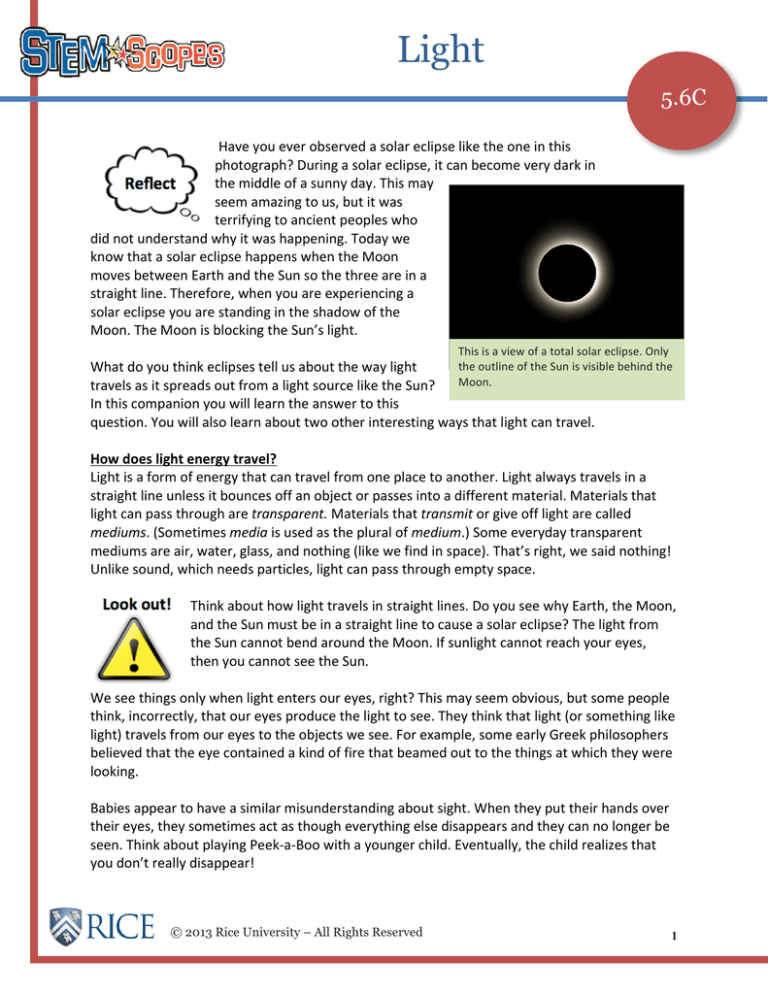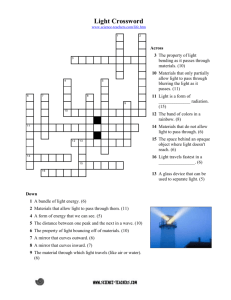
Light
5.6C
Have you ever observed a solar eclipse like the one in this photograph? During a solar eclipse, it can become very dark in the middle of a sunny day. This may seem amazing to us, but it was terrifying to ancient peoples who did not understand why it was happening. Today we know that a solar eclipse happens when the Moon moves between Earth and the Sun so the three are in a straight line. Therefore, when you are experiencing a solar eclipse you are standing in the shadow of the Moon. The Moon is blocking the Sun’s light. This is a view of a total solar eclipse. Only the outline of the Sun is visible behind the What do you think eclipses tell us about the way light travels as it spreads out from a light source like the Sun? Moon. In this companion you will learn the answer to this question. You will also learn about two other interesting ways that light can travel. How does light energy travel? Light is a form of energy that can travel from one place to another. Light always travels in a straight line unless it bounces off an object or passes into a different material. Materials that light can pass through are transparent. Materials that transmit or give off light are called mediums. (Sometimes media is used as the plural of medium.) Some everyday transparent mediums are air, water, glass, and nothing (like we find in space). That’s right, we said nothing! Unlike sound, which needs particles, light can pass through empty space. Think about how light travels in straight lines. Do you see why Earth, the Moon, and the Sun must be in a straight line to cause a solar eclipse? The light from the Sun cannot bend around the Moon. If sunlight cannot reach your eyes, then you cannot see the Sun. We see things only when light enters our eyes, right? This may seem obvious, but some people think, incorrectly, that our eyes produce the light to see. They think that light (or something like light) travels from our eyes to the objects we see. For example, some early Greek philosophers believed that the eye contained a kind of fire that beamed out to the things at which they were looking. Babies appear to have a similar misunderstanding about sight. When they put their hands over their eyes, they sometimes act as though everything else disappears and they can no longer be seen. Think about playing Peek-­‐a-­‐Boo with a younger child. Eventually, the child realizes that you don’t really disappear! © 2013 Rice University – All Rights Reserved
1
Light
5.6C
Suppose you were looking at the reflected image of a mountain on the surface of a lake. Can you trace the path of the light that makes it possible for you to see the reflected image? The answer is: Light travels from the Sun to the mountain to the lake to your eye. It bounces off the surface of the lake. How can the path of light be changed? Remember you learned that light travels in a straight line until it comes to an object or enters a different medium. If light cannot pass through an object, it will be reflected (bounce off), absorbed (go into), or both. Reflection happens when light bounces off the surface of an object. Absorption happens when light enters an object but does not pass through. Shiny surfaces like mirrors reflect almost all light. Black surfaces absorb almost all light. Visible light is made up of all the colors of the rainbow. This range of colors is called the visible light spectrum. Colored objects absorb some colors of light and reflect the color we see. When light passes from one transparent medium to another, it changes speed. When light changes speed, it changes direction. This change of direction, or bending, is called refraction. This image shows a ray of light bending as it passes from air (above the line) into water (below the line). The light ray bends down because light travels more slowly in water than in air. If a light ray sped up as it changed mediums, it would bend in the other direction. Everyday Life: How do mirrors change the path of light? Have you ever noticed anything strange about images in a mirror? What you may have seen is that right and left are reversed. Look at the image of your right hand in a mirror, and then compare it to your real right hand. Odd, isn’t it? Are you familiar with the books Alice’s Adventures in Wonderland and Through the Looking Glass by Lewis Carroll? In the second book, Alice imagines that the world she sees in a large mirror is a real world where everything is slightly different. When she looks at an image of written words in the mirror world, she sees that the people there seem to write from right to left and that some of the letters in their alphabet are different than our letters. If you hold the page of a book up to a mirror, you will see what puzzled Alice. © 2013 Rice University – All Rights Reserved
2
Light
5.6C
You may also have noticed that some letters and some words are the same in the mirror and some are not. Write the words “MOM” and “DAD” on a piece of paper and hold the paper up to a mirror. What do you see? Make a list of all the capital letters that are the same as their mirror images. Use this list to see how many words you can write that look just like their mirror images. Can you find any words that become different words in the mirror? Some species of birds, like pelicans and cormorants, can dive into the water and catch fish. If you tried to catch a fish by throwing a spear at it, you would almost certainly miss. You would miss because the fish would not be where it appears to be. This is because the light reflected from the fish changes direction as it leaves the water and enters the air. This bird is swimming back to the surface Remember, this bending is called refraction. It is interesting that fishing birds have adapted to adjust after trying to catch a fish. You can see how light is refracted as it passes between the their aim to account for refraction. water and the air. Here is an easy way to see how refraction can fool you. Find a thumbtack, a long nail or pencil, and a large, wide bowl with a flat bottom. Place the tack, point up, in the bowl near one side and fill the bowl with water. Bend your head down so you are looking across the bowl at the tack from a low angle. Now slowly lower the nail, point first, into the water and try to touch the point of the tack with the point of the nail. How did you do? What Do You Know? In this exercise you will show what you know about reflection and refraction. In the diagram to the right, the double lines represent a pane of glass and the single line represents a mirror, both shown edgewise. The arrow is a ray of light. Draw the path of the light ray until it reaches Point X. Show how the change in the speed of the light ray affects its direction as it passes from one medium to another. Remember, light travels more slowly in glass than it does in air. HINT: The light will bend both when it enters and exits the glass! © 2013 Rice University – All Rights Reserved
3
Light
5.6C
Building a Periscope A periscope is a tool in which several mirrors at opposite ends of a long tube allow people to see around objects. Designing and building a periscope is an excellent way to learn about the fundamental laws of reflection. Remember that light travels in straight lines and that the angle of incidence (where it hits) equals the angle of reflection (how it bounces off). In other words, the angle at which a light ray approaches a mirror is the same as the angle the light ray bounces off the mirror. Plans and instructional videos for building a periscope can easily be found on the Internet. Use search terms such as “periscope plans.” For most designs, you will need these items: • A long, square box or enough cardboard to make such a box • Two small pocket mirrors • A protractor • A sharp knife The other end of this periscope is inside a submarine under water, where someone • Duct tape is observing events above the surface. As you and your child position the mirrors at either end of the box, explain the significance of the angles at which the mirrors are set. (The first mirror must reflect light entering the periscope toward the mirror at the other end of the periscope. This mirror must then reflect light toward the eyepiece of the periscope.) Perhaps also watch videos of how a periscope is used on board a submarine. Encourage your child to find other uses for the periscope. For example, a periscope can let someone look around a corner or above a couch.
© 2013 Rice University – All Rights Reserved
4




